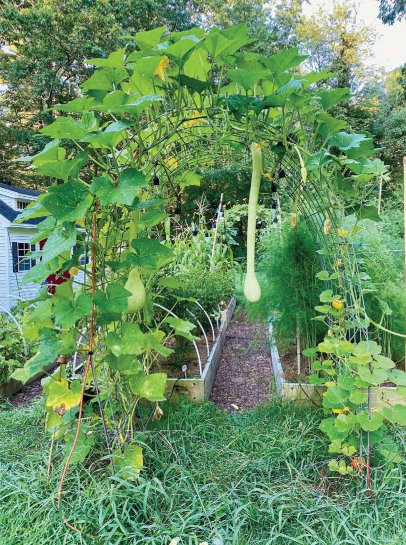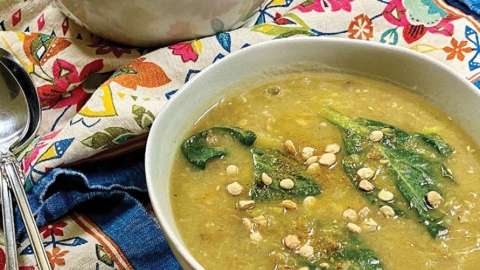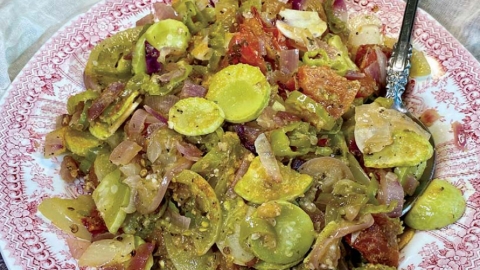Tromboncino: The Saucy Squash
If you have Tromboncino squash growing in your garden next summer, I guarantee you, heads will turn. This phallic squash is definitely a party pleaser, and unlike other varieties, it’s vine borer resistant. It can be harvested as a tender summer squash, or as a more hearty winter squash. It just depends on your mood.
Zucchino Rampicante, as it is more affectionately known, is a beloved Italian heirloom squash. It is a member of the Cucurbitaceae family, along with pumpkins, gourds, and melons. According to the Baker Creek Heirloom Seeds website, “it is one of the best eating summer squash: very tender, mild and sweet tasting.” It is cylindrical, has a long, slender neck, a bulbous end, and when harvested in the middle of the growing season, its thin, light green skin looks as though a very timid artist painted myriad, barely visible, skinny white stripes on it that run from the stem to its blossom end. Because seeds are directly sown in the garden, and it is ready to harvest in as little as 70 days, it can be enjoyed all summer long. But, I implore you, be patient and don’t pick all of the squash that you see growing, even if you really, really want to. Your steadfastness will pay off in the long run.
If you let Tromboncino continue to mature on the vine, and wait until temperatures dip, or until you hear Marvin Gaye singing in your ear before you pick it, you’ll be rewarded. Even though it can be eaten raw and added to salads when it is young, as a winter squash it can be prepared in a variety of delectable ways. It can be hollowed out and stuffed, sautéed, grilled, steamed, baked, or roasted. According to the Specialty Produce website, “Italian households value the Tromboncino squash for its abundant harvest and flavors, and they commonly use the squash to make gnocchi and pasta or sauté it with olive oil and garlic as a stand-alone side dish.” I prefer to make mine into a curried lentil soup, and to freeze leftovers to enjoy later in the season. It’s also a great soup to cook in a slow cooker if you are getting together with friends and want to simplify your life a little. It also pairs really well with wine.
For the past few summers, I attempted growing a variety of summer squash. Crookneck, Yellow Straightneck, zucchini, and yellow zucchini. I also tried coaxing a variety of winter squash and pumpkins. Red Kuri, Delicata, and Galeux d’Eysines. And every year (excluding the first year when I started my 2020 pandemic garden), I had my hopes and dreams dashed by an onslaught of sneaky, dastardly bugs. Specifically, annoying squash bugs and the dreaded squash vine borers. My nemeses.
According to the University of Massachusetts Amherst website, “Adult squash bugs (Anasa tristis) are flat, gray-brown, and usually found on the underside of leaves or in cracks in the soil.” Their favorite plants to frequent are summer squash and zucchini. The undersides of the squash plant’s massive leaves provide a safe haven for squash bugs and their eggs. So, if you’ve seen folks in their garden, precariously holding their cup of coffee in one hand, and peeking at the undersides of leaves with the other, you’ll know what they’re doing. Or, as is typically my case, they may hear a string of expletives.
Squash vine borers, in my opinion, are in a league of their own. One day you’re in your garden proudly admiring the fruits of your labor, and the next, you’re looking at leaf stems that have collapsed and are drooping like they were just insulted by a middle school tween. It happens that fast, and it’s that bad. Again, the University of Massachusetts Amherst site states, “Squash vine borer moths are day-flying “clear wing” moths with a 1.0 to 1.5 inch wingspan, black forewings, clear hind wings, and a bright orange abdomen.” Due to their vibrant color, they’re easy to spot, but they’re skittish. The adult female squash vine borer lays about 200 reddish, oval eggs in its lifetime, most of which can be found on squash plant stems or petioles. The worst of the damage is done by their larvae, though. “Examine the base of vines for evidence of larval feeding (sawdust-like frass near entrance holes) and then split open the stem to confirm the presence of larvae, which suggests more eggs are being laid.”
There are a few remedies that work occasionally. In the past, I’ve wrapped the bases of squash and pumpkin vines in aluminum foil. This is said to deter larvae from boring holes into them when the plants are still young. I’ve also resorted to injecting affected stems with a Bacillus thuringiensis (B.t.) and water solution, which kills larvae within a few days if ingested. It’s a bacterium found in soil. According to the University of Massachusetts Amherst website, “In order to work as a biological insecticide, B.t. or its spores or crystal toxins must be eaten by the insect.” You can also try to find bugs’ eggs at night by using black light flashlights. You might get funny looks from the neighbors, but it’s effective.
If all of this talk of bad bug behavior doesn’t encourage you to make Tromboncino squash your new garden best friend, I don’t know what will. Well, that’s not entirely true. I neglected to share just how large some of last year’s squash grew. Six squash, which were left hanging from the trellis until the middle of October, grew to be obscenely long. The average length was approximately 30 inches, but the longest was 41 inches long. It weighed over seven pounds.
As the Tromboncino ages and transitions from a tender summer squash to a much more hearty winter squash, the color and texture of its skin changes. It’s no longer pale green and easily pierced with a fingernail, but rather a creamy beige color, and its skin is firm to the touch and not easily broken with your fingernail. Tromboncino is not frost tolerant, so they’ll need to be covered with an old sheet, or picked before Jack Frost visits. When you cut the squash off the vine, leave a few inches of the stem intact. According to the Maine-based Johnny’s Selected Seeds, “After cutting the fruits from the vine, sun-cure in the field for 5–7 days, or, cure indoors for 5–7 days at 80–85°F (27–29°C), in an area with good air ventilation.” Once cured, Tromboncino winter squash will last for approximately three to five months.
Winter squash is a staple in my pantry when the temperatures dip below freezing. Not only is it a great comfort food, it’s highly nutritious. According to the U.S. Department of Agriculture, raw winter squash contains “1 gram of protein, 2 grams of total dietary fiber, 48 mg of Calcium, 34 mg of Magnesium, 33 mg of Phosphorus, and a whopping 352 mg of Potassium.”
If gardening isn’t your thing, please support your local farmers during the summer months, or visit winter farmers’ markets to scope out Tromboncino squash. When it’s eaten as a summer squash, it’s delightful. When it’s cured properly and enjoyed as a winter squash, it is phenomenal. And even if you aren’t blown away by its taste, you’ll get a kick out of growing something that will make anyone walking past your garden turn their heads like a seventh grader.
Karen Bento is a freelance writer and photographer, recipe developer, avid gardener, and school librarian. When she is not making a mess in her kitchen, weeding her garden, or taking long walks, she can be found doodling in her journal with broken colored pencils. She can be reached at karenskindredspirit@gmail.com, or you can follow her on Instagram @karenskindredspirit.








